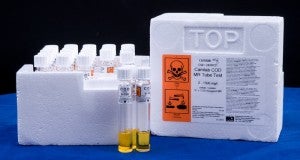A chemical oxygen demand (COD) test is used to measure the amount of organic compounds in a water sample. It measures the capacity of water to consume oxygen during the decomposition of organic matter and the oxidation of inorganic chemicals such as Ammonia and nitrate.
The most common method uses COD vials with overall results being achieved in approx 2-3 hours. Before you start, make sure you choose the COD vials that will measure over the range of COD mg/L you expect to find in your water sample. Watch our video below to see the three simple steps it takes to measure COD using these vials. You can purchase this handy bundle containing all of the equipment needed to get you started with COD measurements.
Can I use Mercury Free vials?
Mercury is an element that is highly toxic to humans, animals and ecosystems. Standard COD vials contain mercury sulphate to remove chloride in a sample, a contaminate which needs to be removed to achieve an accurate COD reading. If you know your samples do not contain chloride, or exists at very low levels, mercury free vials can be used.
You can test whether mercury free vials would be suitable for your testing if you compare results of the same sample with both mercury containing and mercury free vials. Another contaminate that can interfere with mercury free vials is Ammonia. Below are they levels of chloride and ammonia that are acceptable with use with mercury free vials.
- Low range, 0-150 mg/L – Chloride 0 – 100 mg/L – Ammonia 0 – 50 mg/L
- High range, 0-1500 mg/L – Chloride 0 – 200 mg/L – Ammonia 0 – 50 mg/L
- Ultra High range, 0 – 15,000 mg/L – Chloride 0 – 2000 mg/L – Ammonia 0 – 500 mg/


For more information on anything COD get in touch with our technical team on 01954233120, send us an email support@camlab.co.uk or fill in the form below.



































